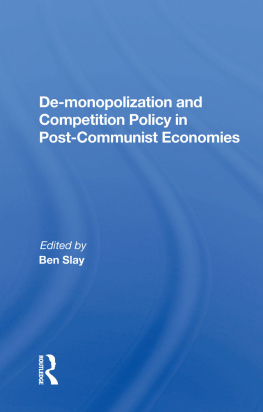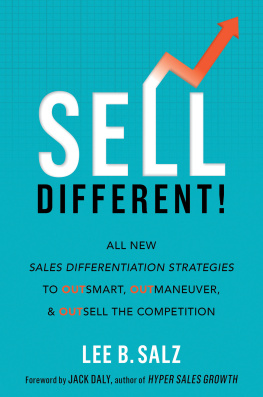
Competition Policy and Price Fixing

LOUIS KAPLOW
Competition Policy and Price Fixing

PRINCETON UNIVERSITY PRESS
PRINCETON AND OXFORD
Copyright 2013 by Princeton University Press
Published by Princeton University Press, 41 William Street, Princeton,
New Jersey 08540
In the United Kingdom: Princeton University Press, 6 Oxford Street,
Woodstock, Oxfordshire OX20 1TW
press.princeton.edu
All Rights Reserved
Library of Congress Cataloging-in-Publication Data
Kaplow, Louis.
Competition policy and price fixing / Louis Kaplow.
pages cm
Includes bibliographical references and index.
ISBN 978-0-691-15862-4 (alk. paper)
1. CompetitionGovernment policy. 2. Antitrust law. 3. Price fixing. I. Title.
HD41.K37 2013
338.6'048dc23 2012047888
British Library Cataloging-in-Publication Data is available
This book has been composed in Minion Pro
Printed on acid-free paper.
Printed in the United States of America
1 3 5 7 9 10 8 6 4 2
For Irene, Leah, and Jody

Preface

Competition policy toward price fixing presents an unrecognized paradox. Commentators, competition agencies, and competition laws throughout the world unanimously condemn the practice, treating it as the fields most important transgression, subject to its harshest sanctions. Yet further scrutiny reveals the prohibitions definition to be incoherent, its practical reach uncertain, and its fit with fundamental economic principles obscure.
Consensus has bred complacency. This book aims to be an antidote. Efficacy demands starting from scratch on two fronts: legal doctrine and economic policy analysis. Misunderstandings about the former constitute a straightjacket that has aborted progress on the latter. Accordingly, the plan of attack is to exhaustively examine the law so as to clear the way for a ground-up assessment of optimal competition policy toward price fixing.
The root of the legal problem lies in competition laws agreement requirement, which demarcates the domain of liability for price fixing. This precondition is examined from multiple perspectives, many underappreciated and some overlooked entirely: basic definitions of key terms, the concept of communications that many see as constitutive of a violation, statutory provisions, higher court interpretations, lower court practice, and basic oligopoly theory. Each inquiry undermines the conventionally endorsed view but is harmonious with the laws reaching all successful coordinated price elevation by oligopolistic firms. This broad convergence should fully extinguish existing inhibitions and stimulate broader study, but it does not suffice to dictate policy because internal coherence does not guarantee optimal consequences for welfare.
A systematic economic investigation of price-fixing policy has three elements: articulating the problem in terms of social welfare, assessing how to detect harmful behavior, and designing appropriate sanctions. Familiar static and often-ignored dynamic effects are examined, followed by the presentation of the appropriate framework for decision-making, a subject that has been largely neglected in the analysis of optimal enforcement quite generally as well as with regard to competition law. Detection is the most challenging element of the analysis. Various techniques are examined with a particular eye to their potential contribution to deterrence and also their tendency to generate false positives, the prospect of which chills desirable conduct. The appropriate magnitude and type of sanctions are determined by reference to the benefits and costs of penalizing underlying conduct.
Finally, the emergent direct economic approach toward price fixing is compared to the traditionally favored proscription that focuses on particulars of firms communicationsa subset of means to an end rather than the end itself. This familiar method is inferior on a priori grounds due to its formalistic nature and poor nexus with the social objective. Unfortunately, it is even worse. The commonly endorsed proscription constitutes a dominated strategy: Compared to the direct approach, it targets cases that generate relatively small deterrence gains and high chilling costs, while exonerating cases where the social danger is greatest and chilling costs are comparatively modest. In addition, contrary to widely held beliefs, it is more complex and costly to implement because it requires an additional, subtle inquiry with little evidence to guide it.
Despite the power of the foregoing conclusions, this book should largely be understood as advancing conceptual understanding rather than specific policy prescriptions. First, it is unavoidably preliminary because it covers so much new territoryindeed, there is remarkably little subject matter overlap with most contemporary literature on the topic. Second, existing empirical knowledge provides limited illumination of many key issues. Third, optimal competition policy, particularly due to its economic complexity, is highly institutionally dependent, and institutions vary widely across the globe and even within some individual jurisdictions, notably, the United States. In sum, this book seeks to invigorate debate, redirect thinking, and guide future research, with the hope of improving the quality of subsequent discourse and, ultimately, of competition policy toward price fixing.
My interest in competition law and policy began as a student. During the course of my education, I have been tremendously lucky in my instructors and mentors: Mike Scherer, Mike Spence, Dick Caves, Mike Porter, and Phil Areeda. I have also benefited from my collaborations with co-authorsPhil Areeda and Aaron Edlin on Antitrust Analysis (a casebook for law students) and Carl Shapiro on Antitrust (a survey aimed at economists).
From the outset of my academic career, the traditional treatment of the price-fixing prohibition has bothered me, and I have always found it difficult to teach material that I could not make sense of for myself. The exception in extant scholarship is Richard Posners 1969 article, followed by a chapter in his book on antitrust, which famously endorses a more economically based strategy for addressing oligopoly pricing. Although these writings have been widely cited, their substance has been largely ignored. The present investigation goes beyond Posners work and departs in many respects, which can hardly be surprising in light of the decades of theoretical and empirical work in industrial organization in the interim. Yet the spirit of his argument as well as some key insights provide invaluable illumination.
In addition to my intellectual forebears, I wish to acknowledge the substantial support I have received over the years working on this project. For helpful discussions and comments, I am grateful to Jon Baker, Ryan Bubb, Aaron Edlin, Joe Harrington, Oliver Hart, Al Klevorick, Carl Shapiro, Steve Shavell, Kathy Spier, reviewers for the Princeton University Press, editors and referees at journals, and workshop and conference participants at Chicago, Columbia, Georgetown, Harvard, Michigan, NYU, Virginia, Yale, the Antitrust Division of the U.S. Department of Justice, Northwesterns Searle Center Antitrust Economics and Competition Policy Conference, and the American Law and Economics Association Annual Meeting. Molly Eskridge, Matt Seccombe, and the team at Princeton University Press provided terrific administrative, editorial, and other assistance. I have also benefited substantially from the efforts of many talented research assistants (with apologies to any accidently omitted): Shobitha Bhat, Josh Branson, Jamison Davies, Danielle DOnfro, Michael Doore, Ariel Fox, Joseph Gay, David Geiger, Barbara Glowacka, David Gottlieb, Jason Green-Lowe, Jesse Gurman, Kinga Guzdek, Anat Holtzman, James Ianelli, Daniel Jacobsen, Noam Lerer, Lauren Merrell, William Milliken, Soojin Nam, Balaji Narain, Max Nicholas, Maria Parra-Orlandoni, Robert Ritchie, Cody Rockey, Krysten Rosen, Michael Sabin, Dorothy Shapiro, and Joseph Vardner. Generous financial support was provided by Harvard Law Schools John M. Olin Center for Law, Economics, and Business; Harvard Law School; the Kaufmann Foundation; and the Leeds Research Fund. Finally, I wish to acknowledge that, in the course of writing this book, I published the following articles drawn from the manuscript: On the Meaning of Horizontal Agreements in Competition Law,
Next page









